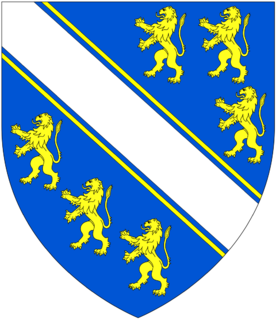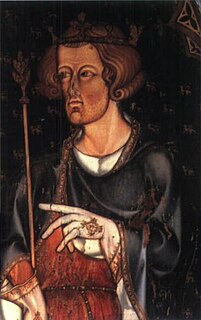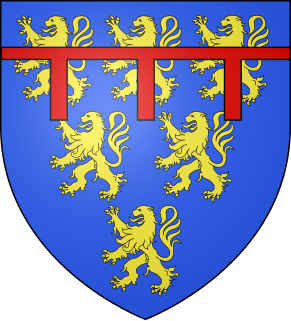
Edward I, also known as Edward Longshanks and the Hammer of the Scots, was King of England from 1272 to 1307. Before his accession to the throne, he was commonly referred to as The Lord Edward. The first son of Henry III, Edward was involved from an early age in the political intrigues of his father's reign, which included an outright rebellion by the English barons. In 1259, he briefly sided with a baronial reform movement, supporting the Provisions of Oxford. After reconciliation with his father, however, he remained loyal throughout the subsequent armed conflict, known as the Second Barons' War. After the Battle of Lewes, Edward was hostage to the rebellious barons, but escaped after a few months and defeated the baronial leader Simon de Montfort at the Battle of Evesham in 1265. Within two years the rebellion was extinguished and, with England pacified, Edward joined the Ninth Crusade to the Holy Land. He was on his way home in 1272 when he was informed that his father had died. Making a slow return, he reached England in 1274 and was crowned at Westminster Abbey.
Robert Burnell was an English bishop who served as Lord Chancellor of England from 1274 to 1292. A native of Shropshire, he served as a minor royal official before entering into the service of Prince Edward, the future King Edward I of England. When Edward went on the Eighth Crusade in 1270, Burnell stayed in England to secure the prince's interests. He served as regent after the death of King Henry III of England while Edward was still on crusade. He was twice elected Archbishop of Canterbury, but his personal life—which included a long-term mistress who was rumoured to have borne him four sons—prevented his confirmation by the papacy. In 1275 Burnell was elected Bishop of Bath and Wells, after Edward had appointed him Lord Chancellor in 1274.

The Menai Strait is a narrow stretch of shallow tidal water about 25 km (16 mi) long, which separates the island of Anglesey from the mainland of Wales. It varies in width from 400 metres (1,300 ft) from Fort Belan to Abermenai Point to 1,100 metres (3,600 ft) from Traeth Gwyllt to Caernarfon Castle. It then narrows to 500 metres (1,600 ft) in the middle reaches and then it broadens again. At Bangor, Garth Pier, it is 900 metres (3,000 ft) wide. It then widens out, and the distance from Puffin Island to Penmaenmawr is about 8 kilometres (5.0 mi).

Beaumaris is a town and community on the Isle of Anglesey in Wales, of which it is the former county town of Anglesey. It is located at the eastern entrance to the Menai Strait, the tidal waterway separating Anglesey from the coast of North Wales. At the 2011 census, its population was 1,938. The community includes Llanfaes.

Menai Bridge is a town and community on the Isle of Anglesey in north-west Wales. It overlooks the Menai Strait and lies by the Menai Suspension Bridge, built in 1826 by Thomas Telford, just over the water from Bangor. With a population of 3,376, it is the fifth largest town on the island. The built-up area including Llandegfan had a population of 4,958.

The Menai Suspension Bridge is a suspension bridge spanning the Menai Strait between the island of Anglesey and the mainland of Wales. Designed by Thomas Telford and completed in 1826, it was the world's first major suspension bridge. The bridge still carries road traffic and is a Grade I listed structure.

Humphrey (VI) de Bohun, 3rd Earl of Hereford and 2nd Earl of Essex, was an English nobleman known primarily for his opposition to King Edward I over the Confirmatio Cartarum. He was also an active participant in the Welsh Wars and maintained for several years a private feud with the earl of Gloucester. His father, Humphrey (V) de Bohun, fought on the side of the rebellious barons in the Barons' War. When Humphrey (V) predeceased his father, Humphrey (VI) became heir to his grandfather, Humphrey (IV). At Humphrey (IV)'s death in 1275, Humphrey (VI) inherited the earldoms of Hereford and Essex. He also inherited major possessions in the Welsh Marches from his mother, Eleanor de Braose.

The Battle of Orewin Bridge was fought between English and Welsh armies on 11 December 1282 near Builth Wells in mid-Wales. It was a decisive defeat for the Welsh because their leader, Llywelyn ap Gruffudd was killed, and this effectively ended the autonomy of Wales.

Jean I de Grailly was the seneschal of the Duchy of Gascony from 1266 to 1268, of the Kingdom of Jerusalem from about 1272 until about 1276, and of Gascony again from 1278 until 1286 or 1287.

Otto de Grandson, sometimes numbered Otto I to distinguish him from later members of his family with the same name, was the most prominent of the Savoyard knights in the service of King Edward I of England, to whom he was the closest personal friend and many of whose interests he shared.
This article is about the particular significance of the century 1201–1300 to Wales and its people.
The Battle of Moel-y-don was a battle fought in 1282 war during the conquest of Wales by Edward I. Also known as the Battle of the Bridge of Boats, it is now considered unlikely the battle site was near Moel-y-don, but farther north.

The conquest of Wales by Edward I, sometimes referred to as the Edwardian Conquest of Wales, to distinguish it from the earlier Norman conquest of Wales, took place between 1277 and 1283. It resulted in the defeat and annexation of the Principality of Wales, and the other last remaining independent Welsh principalities, by Edward I, King of England.

Crickhowell Castle is a Grade I listed building in Crickhowell, Wales, now largely ruined. An alternative name, "Alisby's Castle", is sometimes used; this is thought to be after a former governor of the castle, Gerald Alisby.

Edward I of England was associated with a faction of nobles and knights who came from the County of Savoy, and were favoured in England. Savoy became linked to the Plantaganet monarchy of England with the marriage of Edward I's parents Henry III of England and Eleanor of Provence in 1236. Eleanor of Provence was the daughter of Beatrice of Savoy.

The Gascon campaign of 1294 to 1303 was a military conflict between English and French forces over the Duchy of Aquitaine, including the Duchy of Gascony. The Duchy of Aquitaine was held in fief by King Edward I of England as a vassal of King Philip IV of France. Starting with a fishing fleet dispute and then naval warfare, the conflict escalated to open warfare between the two countries. In spite of a French military victory on the ground, the war ended when the Treaty of Paris was signed in 1303, which restored the status quo. The war was a premise to future tensions between the two nations culminating in the Hundred Years' War.

Stephen Longespée was an English knight who served as Seneschal of Gascony and as Justiciar of Ireland.

John de Havering was an English military and civil servant. He was considered one of the most experienced administrators of King Edward I, serving as Seneschal of Gascony and as Justiciar of North Wales.

Hugh de Turberville was an English noble and soldier.
Roger de Clifford, Lord of Appleby, Master of Topcliffe, was an English noble. He participated in Edward I's conquest of Wales in 1282. From Anglesey, an English force crossed over the Menai Strait where they were defeated at the Battle of Moel-y-don, and Clifford was slain during the battle.















